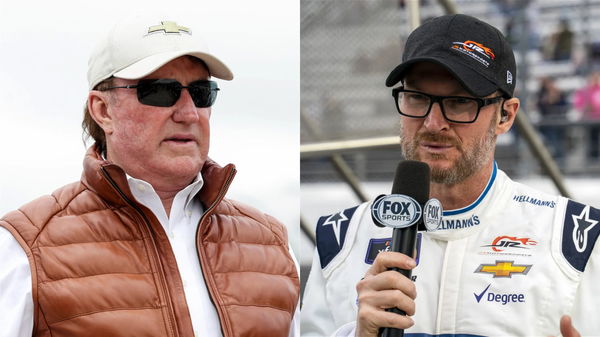
via Imago
Image Credits: Imago

via Imago
Image Credits: Imago
Austin Hill should probably stop dreaming about making friends. An almost permanent member on the bad side of the racing community, thanks to his unconventional and controversial racing methods, it’s no wonder why. Take this season, for example. Already battling a one-race suspension stemming from his clash with Aric Almirola at Indianapolis late last month, he triggered yet another massive wreck in his first race back.
At Watkins Glen, while battling for second at Lap 74, Hill contacted Michael McDowell while running wide through the exit of Turn 5. The aftermath was a 16-car pileup, and the Spire Motorsports driver ultimately finishing P19. “He turned me for sure. I mean, there is no way he was gonna get alongside me,” the veteran racer later complained. And it’s not just McDowell whose been critical of the racer’s antics. Even industry bigwigs like Dale Earnhardt Jr have hardly minced their words.
After the infamous Indy wreck, the JRM Motorsports owner had pointedly called out the RCR racer, mentioning how he didn’t “buy” Hill’s explanations. And clearly, this lack of love has also translated into a rather veiled animosity on track with JRM… As per a tweet by industry insider Matt Weaver on August 22, the driver complained about his lack of connections in the community after the 2025 Mission 200 at The Glen concluded. Captioned, “Austin Hill on what happened in the crash, not having a lot of friends and help at the end of these races, and if his playoff point scenario made him race any differently,” he pointed out, “We never have the JRM cars help us. It doesn’t matter if they’re Chevy alliance or not. They don’t help us at all.”
ADVERTISEMENT
Article continues below this ad
“They would rarely work with the Toyota or Ford than us. So we already know that our backs are against the wall when it comes to the JRM cars. The Toyota definitely doesn’t work with us. The Fords actually probably work with us the best. And then there are some outliers, like with the Chevy camp that works with us,” Hill further said.
Poll of the day
Poll 1 of 5
AD
“So as soon as I saw that restart go down the way it did and the 70 popped out, I got shucked out and the eight was behind me. I knew I was probably a sitting duck, even if I had gone and blocked that run that was coming off of two. He probably would have faked backed up, and I would have probably gotten stuck middle. So, yeah, when you have you know three or four JRM cars up there like that, I mean, it’s all you can do to keep them behind you, so it just didn’t work out for us,” he concluded about the Watkins Glen incident.
Well, the good thing is Hill still clawed out a fourth-place finish.
Austin Hill on what happened in the crash, not having a lot of friends and help at the end of these races, and if his playoff point scenario made him race any differently pic.twitter.com/ztp8lxEdQ7
— Matt Weaver (@MattWeaverRA) August 23, 2025
Having said that, his return from suspension put him back in the car, but Watkins Glen proved that being cleared to race is not the same as being welcomed back into the fold.
What’s your perspective on:
Is Austin Hill's aggressive style a bold move or a recipe for disaster in NASCAR?
Have an interesting take?
ADVERTISEMENT
Article continues below this ad
Hamlin dissects Hill’s blind spot error at Watkins Glen
On his Actions Detrimental podcast, Denny Hamlin delivered a peer-level critique of Austin Hill’s split-second decision at Watkins Glen, one that triggered one of the biggest wrecks the track has seen. The Joe Gibbs Racing driver emphasized that Hill had the opportunity to step off the gas exiting Turn 5 and chose not to. That hesitation, Hamlin argued, wasn’t just risky; it ignored the track’s invisible blackout zone where spotters lose positional awareness.
“I mean, I think he covered it well. He could have lifted. He probably should have lifted. But he didn’t. He’s just not going to get the benefit of the doubt from the general public, but I am like, ‘Okay, let me just think about this in an unbiased way,’ and I feel like I’m unbiased on Austin Hill. But even here he was there, he was outside. But here’s what he didn’t take into account is that that is a part of the racetrack where the spotters have no idea where you’re at,” Hamlin said.
“So, thinking that Michael McDowell is going to know that you’re there at that portion of the track, there’s no chance. No chance of that. He’s supposed to go to the right quicker. So they both swung out, but Austin got the run on the outside. There’s a wall here. What the 11 should have done is hedged more towards getting, got to get back on the track sooner than later,” Denny Hamlin added.
ADVERTISEMENT
Article continues below this ad
Hamlin framed it as a mistake in timing, pushing into a zone where control and coordination evaporate fast. He viewed it not as malicious, but as a tactical misstep. The result was catastrophic: McDowell was catapulted into the barrier, triggering a 16-car pileup and a 45-minute red-flag stoppage. On a road course that combines high-speed aggression with strict technical constraints, Hamlin’s perspective highlighted the razor-thin line separating boldness from recklessness.
Perhaps Hill can take a lesson or two from the incident. Do you think he will? Let us know your opinions in the comments down below.
ADVERTISEMENT
ADVERTISEMENT
ADVERTISEMENT
ADVERTISEMENT


Is Austin Hill's aggressive style a bold move or a recipe for disaster in NASCAR?